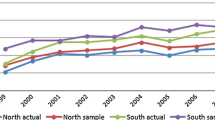Abstract
This study measures productivity growth on Irish dairy farms over the period 1984–2000. A total factor productivity index is constructed for the dairy system and is decomposed into technical change, efficiency change, and changes in scale efficiency. This is achieved by estimating a stochastic output distance function model of the production technology in use on Irish dairy farms. Overall, productivity on Irish dairy farms grew by 1.2% per annum over the sample period.

Similar content being viewed by others
Notes
For properties of the output set see Kumbhakar and Lovell (2000).
It is also possible to assume that the data are characterized by input-oriented inefficiency. However, in the presence of virtually constant returns to scale, as found in this empirical exercise, output and input orientations will yield the same technologies (see Orea et al. 2004).
The output distance function must satisfy certain properties, which follow from those underlying the production technology. For these properties (see Kumbhakar and Lovell 2000).
In the absence, of farm specific price data the level effect of prices on efficiency cannot be incorporated into the model. As such in the presence of allocative inefficiency, technical efficiency estimates will be biased.
Table 1 presents values in 1990 £IR and € values. All other data is presented in 1990 £IR values only.
As milk output was constrained by quota limits throughout this period, milk output per farm could grow only because of a reduction in the number of dairy farms or a transfer of quota between farms.
Boyle (2002) notes that total production costs begin to flatten out at relatively modest herd sizes (50–60 cows). These results are consistent with his finding.
It should be noted that the Battese and Coelli (1992) model estimates a rate of efficiency that relies on the initial efficiency level and the sign and magnitude of η, implying that for η < 0 efficiency always decreases. The computation of efficiency change presented in Eq. (16) however leads to efficiency levels which both increase and decrease over time. This can be explained first by the fact that this paper employs an unbalanced panel of farms, which means that in each year, efficiency levels are averaged over different units and secondly by the fact that population weights are applied to the efficiency levels of each farm in the computation of the index. η on the other hand is an unweighted average rate of change in efficiency levels across all farms in each year and takes no account of the unbalanced nature of the panel.
The two smallest size groupings, less than 10 ha and 10–20 ha, are grouped together due to small sample sizes in later time periods.
References
Balk B (1998) Industrial price, quantity and productivity indices: the micro-economic theory and application. Kluwer Academic Publishers, Boston
Battese G, Coelli T (1992) A model for technical inefficiency effects in a stochastic frontier production function for panel data: with application to paddy farmers in India. J Prod Anal 3:153–169
Battese G, Rao DSP, O’Donnell C (2004) A metafrontier production function for estimation of technical efficiencies and technology gaps for firms operating under different technologies. J Prod Anal 21:91–103
Boyle G. (2002) The competitiveness of Irish agriculture. Irish Farmers Journal, Dublin
Brummer B, Glauben T, Thijssen G (2002) Decomposition of productivity growth using distance functions: the case of dairy farms in three European countries. Am J Agric Econ 84:628–644
Caves D, Christensen L, Diewert WE (1982) The economic theory of index numbers and the measurement of input, output and productivity. Econometrica 50:1393–414
Coelli T, Rao DSP, Battese GE (1998) An introduction to efficiency and productivity analysis. Kluwer Academic Publishers, MA
Coelli T, Perelman S (1996) Efficiency measurement, multiple-output technologies and distance functions: with application to European railways. Working Paper No. 96/05. Centre de Recherche en Economie, Publique
Department of Agriculture and Food (2005) Annual review and outlook 2004/2005. Department of Agriculture and Food, Dublin
Färe R, Primont D (1995) Multi-output production and duality: theory and application. Kluwer Academic Publishers, Boston
Kumbhakar S, Lovell CAK (2000) Stochastic Frontier analysis. Cambridge University Press, Cambridge
O’Neill S, Matthews A (2001) Technical change and efficiency in irish agriculture. Econ Soc Rev 32:263–284
Orea L (2002) Parametric decomposition of a generalized malmquist productivity index. J Prod Anal 18:5–22
Orea L, Roibás D, Wall A (2004) Choosing the technical efficiency orientation to analyze firm’s technology: a model selection test approach. J Prod Anal 22:51–71
Prospectus (2003) Strategic development plan for the Irish dairy processing sector. Promar International, Dublin
Stata Corporation (2003) Stata/SE 8.0 for windows. Stata Corporation, TX
Thorne F (2004) Measuring the competitiveness of Irish agriculture (1996–2000). Rural Economy, Athenry, Rural Economy Research Series No. 9, Teagasc
Acknowledgments
This study was completed with financial support provided by the Irish Department of Agriculture and Food from the Research Stimulus Fund of the National Development Plan 2000–2006. The authors are grateful to Teagasc, the Irish Agriculture and Food Development Authority for permitting the use of the data.
Author information
Authors and Affiliations
Corresponding author
Appendix
Appendix
Rights and permissions
About this article
Cite this article
Newman, C., Matthews, A. The productivity performance of Irish dairy farms 1984–2000: a multiple output distance function approach. J Prod Anal 26, 191–205 (2006). https://doi.org/10.1007/s11123-006-0013-7
Published:
Issue Date:
DOI: https://doi.org/10.1007/s11123-006-0013-7




